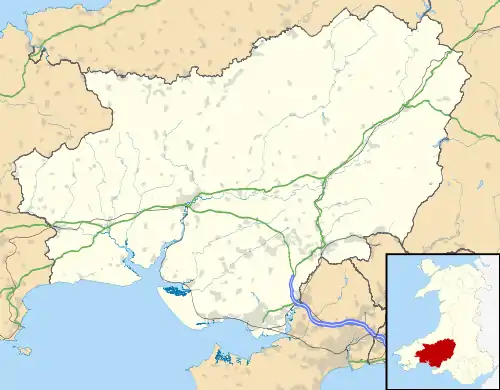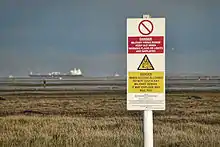RAF Pembrey
Royal Air Force Pembrey or RAF Pembrey was a Royal Air Force station located near the village of Pembrey, Carmarthenshire, 3 miles (4.8 km) northwest of Burry Port and 10.3 miles (16.6 km) south of Carmarthen, Wales. It remains in use as Pembrey Sands Air Weapons Range.
| RAF Pembrey Pembrey Sands Air Weapons Range | |||||||||||
|---|---|---|---|---|---|---|---|---|---|---|---|
| Pembrey, Carmarthenshire in Wales | |||||||||||
 Airfield defence coordination post | |||||||||||
 RAF Pembrey Shown within Carmarthenshire | |||||||||||
| Coordinates | 51°42′27″N 004°18′54″W | ||||||||||
| Type | Royal Air Force station | ||||||||||
| Site information | |||||||||||
| Owner | Defence Infrastructure Organisation | ||||||||||
| Operator | Royal Air Force | ||||||||||
| Site history | |||||||||||
| Built | 1939 | ||||||||||
| In use | 1939-1957 | ||||||||||
| Battles/wars | Second World War Cold War | ||||||||||
| Airfield information | |||||||||||
| Elevation | 5 metres (16 ft) AMSL | ||||||||||
| |||||||||||
Station history
Origin
Construction of the airfield for RAF Training Command started in 1937. The airfield opened in March 1939,[1] and by September 1939 the RAF's No. 2 Air Armament School was the first unit to be stationed at the airfield.
Second World War
During the Second World War, RAF Pembrey was the airfield base for many of the period's flying aces, and Wing Commander Guy Gibson of the Dambusters.
By May 1940, the three tarmac runways were completed and the airfield transferred initially to 11 Group RAF Fighter Command and then to the newly formed 10 Group RAF Fighter Command. Supermarine Spitfire pilots of 92 Squadron used Pembrey as their base from 18 June 1940, including Squadron Leader Stanford Tuck,[2] until 12 August,[3][4] Geoffrey Wellum the author of the 2002 memoir, "First Light", and Tony Bartley. During the Battle of Britain, 92 Squadron pilots who were to be at readiness at dawn spent the night in a tent set up near the aircraft.[5]
During this period Pembrey gained honours as a Battle of Britain Airfield. Pembrey became a Sector Station within 10 Group, relinquishing this role in October 1941 to RAF Fairwood Common after it had returned to RAF Flying Training Command a few months earlier.
From January to March 1941, 256 Squadron operated from Pembrey.[6] In early 1941, Polish Air Force Squadron 316 was formed at Pembrey, inflicted losses on enemy aircraft, and moved on to RAF Colerne in June.[7]

Between 1941 and 1945 Pembrey was host to the RAF's No. 1 Air Gunners School, involving Bristol Blenheim and Vickers Wellington bombers and Spitfire fighter aircraft,[8] and included experimental courses.[9] From 1943 to 1945 Wing Commander George Peter Macdonald was Commanding Officer, No. 1 Air Gunners School, and Station Commander of RAF Pembrey.[10] The airfield is the site of one of only five Dome Trainer Buildings (for training AA gunners) still existing in the UK.
Fortunate gain of an enemy aircraft
In June 1942, a Focke-Wulf Fw 190 landed here in error after a dog fight over the Bristol Channel. Oberleutnant Armin Faber, adjutant of III fighter Gruppe of JG2, had been engaged by Spitfires of 19 Squadron and the Czech Wing over south Devon, England on 23 June. Being forced north beyond Exeter, Faber mistook the Bristol Channel for the English Channel. Short on fuel, he landed at Pembrey, believing it to be a Luftwaffe airfield in the Cotentin Peninsula, Normandy, France.[11] The Pembrey Duty Pilot grabbed a Very pistol, ran from the control tower, and jumped onto the wing of Faber's aircraft as it taxied. Faber was taken to RAF Fairwood Common by Group Captain David Atcherley for interrogation. He became a POW in Canada and was repatriated to Germany in exchange for wounded allied POWs. It is thought that he then fought on the eastern front.
Faber was piloting the latest enemy fighter, the Focke-Wulf 190A-3, a type the RAF had only seen flying over France. The depths of Faber's despair at providing his enemy with an intact Fw 190 can be gauged by the fact that he subsequently attempted to commit suicide. As news broke of his landing in Pembrey, Fighter Command dispatched pilots to photograph and return the aircraft to the Royal Aircraft Establishment at Farnborough. The RAF finally had an Fw 190 to compare with its V.S Spitfire IX and Hawker Typhoon Ia aircraft.[12]
Postwar
At the end of the war RAF Pembrey became home to No. 3 Air Crew Holding Unit for those being demobilised.
In 1946 RAF Fighter Command once again took over as custodians of the airfield with aircraft staying to 1949. Work was then put in hand to lengthen Runway 04/22 to take jet aircraft. From 1949 to 1952 21 Wing RAF Regiment (comprising 15 and 63 Squadrons RAF Regiment) were based at Pembrey. With Runway 04/22 extended to nearly 6000 feet, 1 September 1952 the airfield became home to 233 Operational Conversion Unit which flew de Havilland Vampires and Hawker Hunters until its closure on 13 July 1957.
In September 1953 a Vampire crashed at the airfield, killing the pilot, Squadron Leader Lionel Hubert Wakeford DFC.[13] Shortly before closure, in June 1957, a Hunter I (WT563) crashed on approach to the airfield, killing Pilot Officer Frederick William Rupert Vernon Jacques when he ejected at low level; the aircraft crashed into Kidwelly railway station.[14][15] Both airmen were buried in St Illtyd Churchyard, Pembrey, along with 32 wartime RAF casualties, including seven from the Polish Air Force.[16]
Post 1958 part of former RAF Pembrey airfield was turned over to agriculture and part was used as a motor racing circuit leaving only a small length of unused runway and taxiways. Most of the hangars were dismantled in 1962.
In 1968 a bomb exploded at the airfield, seriously injuring a warrant officer; in the "climate of sporadic bomb threats" the BBC interviewed people in Kidwelly about whether they believed The Prince of Wales should come to Wales.[17]
On Thursday 22 August 1997 Pembrey was officially opened as a civil airfield and named Pembrey Airport using a single runway (04/22) with a declared length of 805 metres.
Squadrons
Pembrey was host to many squadrons and aircraft types during its active history,[18] for example—
- Nos 595/5, 92, 118 (Spitfires)
- Nos 32, 79, 316 - formed at Pembrey. (Hurricanes)
- Nos 238, 248. (Beaufighters)
- Nos 256, 307. (Boulton Paul Defiants)
- No. 233 OCU (Vampires, Tempests, Mosquitos, Meteors and Hunters)
The following units were also here at some point:[1]
- No. 1 Bombing and Gunnery School RAF
- No. 14 Operational Training Unit RAF
- No. 41 Gliding School RAF
- No. 225 Squadron RAF
- No. 2742 Squadron RAF Regiment
- No. 2875 Squadron RAF Regiment
- Air Sea Rescue Flight, Pembrey/Fairwood Common RAF
- Pembrey Station Flight
Current use

Pembrey is still associated as a service facility with the former RAF Pembrey Sands Air Weapons Range, now a Defence Infrastructure Organisation (DIO) establishment.[19] The airfield is now split into a number of facilities: the Welsh Motor Sports Centre occupies most of the area, part of the land has reverted to agriculture, part contains a hangar formerly used by the Dyfed-Powys Police Air Support, whilst 805 metres (2,641 ft) of the north east portion of the former RAF Runway 04/22 was opened as Pembrey Airport in August 1997 (ICAO code is EGFP). The airfield is also home to the Llanelli Model Flying Club.[20]
RAF/RN/RM/British Army aircraft use Pembrey Airport (EGFP) to support the nearby range, known as Pembrey Sands Air Weapons Range. The range was built on land that was not part of RAF Station Pembrey and opened in 1966 (ICAO code for Pembrey Sands Air Weapons Range is EGOP). Defence Infrastructure Organisation (DIO) administers the site with RAF Air Traffic Control personnel manning Range Control supported by civilian contract personnel employed by Landmarc Support Services.
Pembrey West Wales Airport ltd EGFP remains a working airfield and provides training for the Ministry of Defense and provides services to General Aviation which includes Flight Training ,Air Charter flight, Aircraft Maintenance and Air Cargo services the runway has been extended to 1200 metres and the runway is capable aircraft weights up to 90 tons .
See also
References
| Wikimedia Commons has media related to RAF Pembrey. |
- "Pembrey". Airfields of Britain Conservation Trust. Retrieved 9 June 2020.
- "Llanelli Community Heritage". Retrieved 3 August 2014.
- "92 Squadron RAF - Pembrey". Retrieved 3 August 2014.
- "Ground Crew Life with 92 Squadron". Retrieved 3 August 2014.
- Geoffrey Wellum, First Light (New York, John Wiley & Sons, 2002), p 108.
- "Wartime Memories Project - 256 Squadron". Retrieved 3 August 2014.
- "1941 - 316 Squadron". Retrieved 3 August 2014.
- "Kidwelly history - RAF Pembrey". Retrieved 3 August 2014.
- "National Archives - Experimental Gunnery Courses". Retrieved 3 August 2014.
- "RAF Officers, 1939-1945". Retrieved 3 August 2014.
- Nazi Germany's Focke-Wulf FW-190: The Best Fighter Aircraft of World War II? at nationalinterest.org, 10 August 2017. Retrieved 7 January 2020
- Weal, John (1996). Focke-Wulf Fw 190 Aces of the Western Front. Osprey Publishing. p. 24-25. ISBN 9781855325951. Retrieved 3 August 2014.
- "216 Association History". Retrieved 3 August 2014.
- "Aviation Safety Network - Aircraft accident, 20-Jun-1957". Retrieved 3 August 2014.
- "National Archives - Air accident report". Retrieved 3 August 2014.
- "Pembrey RAF Burials". Retrieved 3 August 2014.
- "Kidwelly on the bomb attacks". BBC. 10 September 1968. Retrieved 3 August 2014.
- "A History of RAF Organisation". Retrieved 3 August 2014.
- "CRO Wales - The RAF in Wales". Retrieved 3 August 2014.
- "RAF Pembrey Flying Site". Retrieved 3 August 2014.
Bibliography
- Smith, David, J. (1981). Action Stations. 3: Military airfields of Wales and the North West. Cambridge: Patrick Stephens Ltd. ISBN 0-85059-485-5.

